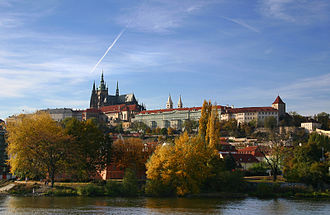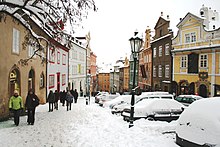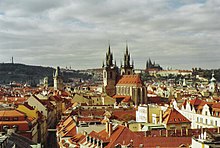Prague
![]()
Praha is a redirect to this article. For other meanings see Prague (disambiguation) and Praha (disambiguation).
Prague (Czech Praha [ˈpraɦa];![]() ) is the capital and also the most populous city of the Czech Republic. With over 1.3 million inhabitants, Prague ranks thirteenth among the largest cities in the European Union. The capital city of Prague is one of the 14 regions of the Czech Republic and one of the richest regions in Europe.
) is the capital and also the most populous city of the Czech Republic. With over 1.3 million inhabitants, Prague ranks thirteenth among the largest cities in the European Union. The capital city of Prague is one of the 14 regions of the Czech Republic and one of the richest regions in Europe.
Prague is the historical capital of Bohemia and was an important royal and imperial seat in the Holy Roman Empire, especially under the Přemyslids, Luxemburgers and Habsburgs. Around 1230, the settlement, which had been inhabited since early history, was elevated to the status of a royal city, and in the 14th century, under the reign of Charles IV, it became a political and cultural centre in Europe. Charles University, the first university in Central Europe, was founded in Prague in 1348. The Conservatory and the Technical University are also among the oldest of their kind in Europe. For centuries, Prague was a city where Czech, German and Jewish cultures met.
The historic centre of Prague has been recognised by UNESCO as one of the Czech Republic's 14 World Heritage Sites since 1992. Today, the "Golden City" displays a cohesive cityscape influenced by Gothic and Baroque styles. Sights such as Prague Castle, Charles Bridge, the medieval Town Hall Clock, the Jewish cemetery or the oldest active synagogue in the world make the city a popular tourist destination. With more than five million foreign tourists a year, Prague is one of the ten most visited cities in Europe.

Prague Castle above the Vltava River
Geography
Location
Prague is centrally located in the western Czech Republic on the Vltava River, about 40 kilometres from its confluence with the Elbe at Mělník. The distance to the outermost border points is about 110 kilometres to the north, about 170 kilometres each to the west and south, and about 320 kilometres to the east (about 170 kilometres to the old eastern border of Bohemia, as the crow flies).
A large part of the city lies in a wide valley of the Vltava River, which flows through the city area for 30 kilometres and forms a large loop in the northern part. On the southern bend of this loop lies the historic city centre, dominated by the two castle hills Hradčany (Hradčany) to the north and Vyšehrad to the south. The rest is distributed among other hills surrounding the valley: Letná, Vítkov, Větrov, Skalka, Emauzy, Karlov and the highest of them, Petřín. As a result of incorporations, mainly in the 20th century, the city area now extends far into the Pražská plošina (Prague Plateau). Thus, some natural beauties such as the Šárka Valley and the Modřany Gorge also belong to the town.
The Vltava River enters the city area in the south at a height of about 190 meters and leaves it in the north at about 176 meters. It has an average depth here of 2.75 metres with a greatest depth of 10.5 metres. It flows around several islands, including the Slovanský ostrov, Dětský ostrov and Střelecký ostrov to the south of the Charles Bridge, as well as the Kampa supporting the western part of the Charles Bridge, and takes in numerous watercourses, among which the largest are the Berounka north of Zbraslav (from the west), the Botič between the New Town and Vyšehrad (from the east) and the Rokytka in the port of Libeň (also from the east).
The highest altitudes are in the west and south of the city. In the west, Bílá hora (White Mountain) reaches 381 meters, and 397 meters are measured at the city limits southwest of it. In the south, Čihadlo rises to 385 metres.
Politically, Prague is entirely surrounded by the region of Central Bohemia (Středočeský kraj).

enlarge and show information about the picture
![]()
View from Petřín towards east
Climate
Prague's mild climate is influenced by both Atlantic and continental conditions. The average annual temperature is around 8 °C, with winter temperatures as low as -17 °C and summer temperatures as high as 35 °C (2006). Most precipitation falls in the summer half-year (May: 77 mm), the winter half-year is relatively dry (October to March: 23 to 32 mm). (all data related to the meteorological station at Ruzyně Airport)
Compared with the long-term average for the years 1961 to 1990 (international reference period), an increase in temperature values of about 1 degree and a decrease in precipitation of about 20 millimetres have been observed in recent years (see also the adjacent climate graphs for the periods 1961-1990, 1991-2005 and 1961-2005).
The data for the meteorological station in Karlov (Prague New Town) show both higher temperatures and lower precipitation, along with the warmer and drier trends of previous years; however, it must be taken into account that the inner city location strongly influences the weather data.
| Prague | ||||||||||||||||||||||||||||||||||||||||||||||||
| Climate diagram | ||||||||||||||||||||||||||||||||||||||||||||||||
| ||||||||||||||||||||||||||||||||||||||||||||||||
| Monthly average temperatures and precipitation for Prague
Source: Czech Hydrometeorological Institute (ČHMÚ) | ||||||||||||||||||||||||||||||||||||||||||||||||||||||||||||||||||||||||||||||||||||||||||||||||||||||||||||||||||||||||||||||||||||||||||||||||||||||||||||||||||||||||||||||||||||||||||||||||

Nerudova Street on the Lesser Town in winter (2010)
Place name
Etymology
There are two suggestions for the origin of the name Praha (Prague, Praga). On the one hand, a connection with práh "beam, threshold" is assumed, with reference to wooden beams that would have straightened the Vltava River. Another theory, considered more likely by Max Vasmer, is a connection with the word pražit "to burn" (presumed name motif of slash-and-burn).
In the founding legend attested by the chronicler Cosmas, the name is etymologized with reference to the word for "threshold". The founder of the city, Libuše, is said to have sent her entourage into a forest to cut a threshold out of a tree. Prague is said to have been founded by Libuše on this spot.
Golden city of a hundred towers
The nickname "Golden City" refers to the sandstone towers, which shimmer in golden tones when the sun shines. Another explanation for this name is that Emperor Charles IV had the towers of Prague Castle gilded. In addition, the city was an attraction for alchemists during the time of Rudolf II.
The name "City of a Hundred Towers" has also been known for several centuries and comes from the numerous towers that characterise the historic townscape.
The merchant Ibrahim ibn Yaqub referred to Prague in the second half of the 10th century as "the city built of stone and lime" or "Stone Prague". Other epithets for Prague include Praga totius Bohemiae domina (Prague, the mistress of all Bohemia) and Praga mater urbium (Prague, the mother of all cities). In the Middle Ages, Prague was called Praga caput regni (Prague, the head of the kingdom), today modified as a heraldic motto to Praga caput rei publicae (head of the republic).

The "Golden City" seen from the Powder Tower

Vltava bridges in Prague
Questions and Answers
Q: What is Prague?
A: Prague is the capital and largest city of the Czech Republic.
Q: How many people live in Prague?
A: 1.4 million people live in Prague.
Q: What is Prague known for?
A: Prague is known as one of the most beautiful European cities since the Middle Ages. It is often called the "City of 100 Towers", the "Rooftop of Europe" or the "Heart of Europe."
Q: What kind of people met in Prague?
A: Many merchants, artists and inventors met in Prague.
Q: What is the historic center of Prague?
A: The historic center of Prague is on both banks of the Vltava river, and it has six districts: Staré Město (Old Town), Pražský hrad (Prague castle), Josefov (Old Jewish Town), Nové Město (New Town), Malá Strana (Lesser Town), Hradčany (Prague Castle Quarter) and Vyšehrad.
Q: Who established Prague Castle?
A: Prince Bořivoj established Prague Castle.
Q: What other buildings are there in Prague besides historical monuments?
A: There are also lots of museums, galleries, theaters, concert halls, and other historic buildings in Prague.
Search within the encyclopedia